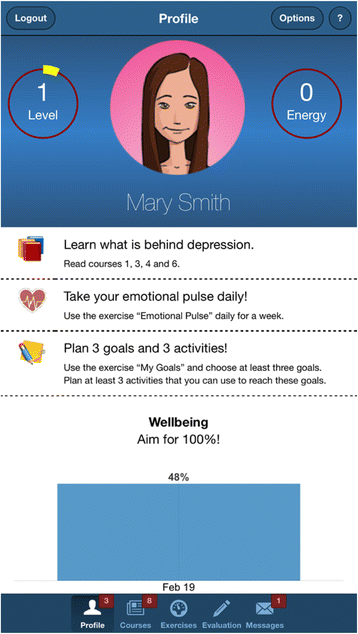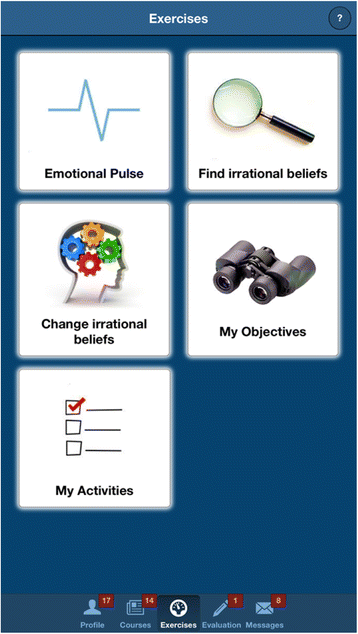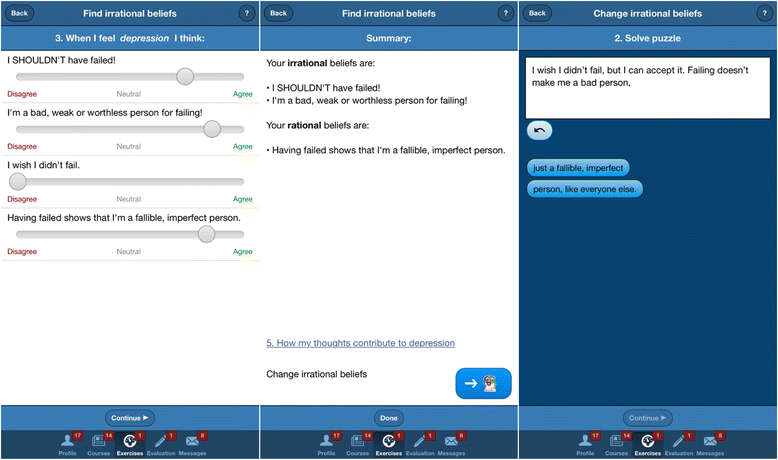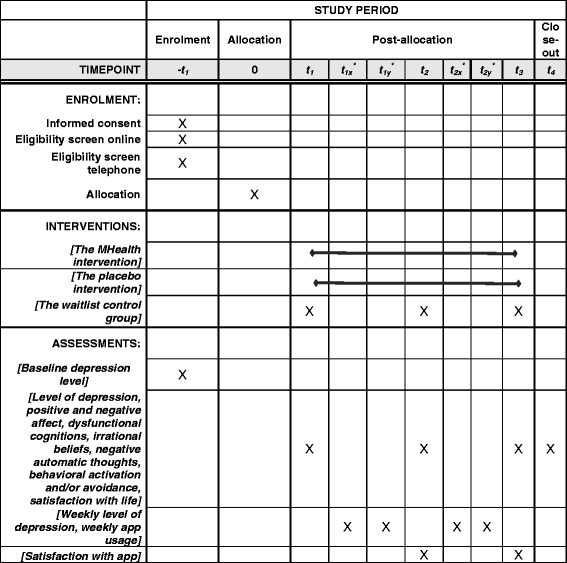Reducing depressive symptomatology with a smartphone app: study protocol for a randomized, placebo-controlled trial
- PMID: 28494802
- PMCID: PMC5427551
- DOI: 10.1186/s13063-017-1960-1
Reducing depressive symptomatology with a smartphone app: study protocol for a randomized, placebo-controlled trial
Abstract
Background: Depression has become one of the leading contributors to the global disease burden. Evidence-based treatments for depression are available, but access to them is still limited in some instances. As technology has become more integrated into mental health care, computerized cognitive behavioral therapy (CBT) protocols have become available and have been recently transposed to mobile environments (e.g., smartphones) in the form of "apps." Preliminary research on some depression apps has shown promising results in reducing subthreshold or mild to moderate depressive symptoms. However, this small number of studies reports a low statistical power and they have not yet been replicated. Moreover, none of them included an active placebo comparison group. This is problematic, as a "digital placebo effect" may explain some of the positive effects documented until now. The aim of this study is to test a newly developed mobile app firmly grounded in the CBT theory of depression to determine whether this app is clinically useful in decreasing moderate depressive symptoms when compared with an active placebo. Additionally, we are interested in the app's effect on emotional wellbeing and depressogenic cognitions.
Methods/design: Romanian-speaking adults (18 years and older) with access to a computer and the Internet and owning a smartphone are included in the study. A randomized, three-arm clinical trial is being conducted (i.e., active intervention, placebo intervention and delayed intervention). Two hundred and twenty participants with moderate depressive symptoms (i.e., obtaining scores >9 and ≤16 on the Patient Health Questionnaire, PHQ-9) will be randomized to the three conditions. Participants undergoing therapy, presenting serious mental health problems, or legal or health issues that would prevent them from using the app, as well as participants reporting suicidal ideation are excluded. Participants randomized to the active and placebo interventions will use the smartphone app for 6 weeks. A short therapist check-in via phone will take place every week. Participants in the delayed-intervention condition will be given access to the app after 6 weeks from randomization. The primary outcome is the level of depressive symptomatology. The intervention delivered through the app to the active condition includes psychoeducational materials and exercises based on CBT for depression, while the placebo intervention uses a sham version of the app (i.e., similar structure of courses and exercises).
Discussion: To our knowledge, this study protocol is the first to test the efficacy of a smartphone app for depressive symptomatology in the form of a randomized controlled trial (RCT) that includes an active placebo condition. As such, this can substantially add to the body of evidence supporting the use of apps designed to decrease depression.
Trial registration: ClinicalTrials.gov, identifier: NCT03060200 . Registered on 1 February 2017. The first participant was enrolled on 17 February 2017.
Keywords: CBT; Depression; Placebo; Protocol; Randomized trial; Smartphone app.
Figures





Similar articles
-
Using a smartphone app to reduce cognitive vulnerability and mild depressive symptoms: Study protocol of an exploratory randomized controlled trial.Trials. 2016 Dec 28;17(1):609. doi: 10.1186/s13063-016-1740-3. Trials. 2016. PMID: 28031038 Free PMC article. Clinical Trial.
-
Adding smartphone-based cognitive-behavior therapy to pharmacotherapy for major depression (FLATT project): study protocol for a randomized controlled trial.Trials. 2015 Jul 7;16:293. doi: 10.1186/s13063-015-0805-z. Trials. 2015. PMID: 26149441 Free PMC article. Clinical Trial.
-
Smartphone Cognitive Behavioral Therapy as an Adjunct to Pharmacotherapy for Refractory Depression: Randomized Controlled Trial.J Med Internet Res. 2017 Nov 3;19(11):e373. doi: 10.2196/jmir.8602. J Med Internet Res. 2017. PMID: 29101095 Free PMC article. Clinical Trial.
-
Dropout rates in clinical trials of smartphone apps for depressive symptoms: A systematic review and meta-analysis.J Affect Disord. 2020 Feb 15;263:413-419. doi: 10.1016/j.jad.2019.11.167. Epub 2019 Dec 3. J Affect Disord. 2020. PMID: 31969272
-
Just-in-Time Adaptive Mechanisms of Popular Mobile Apps for Individuals With Depression: Systematic App Search and Literature Review.J Med Internet Res. 2021 Sep 28;23(9):e29412. doi: 10.2196/29412. J Med Internet Res. 2021. PMID: 34309569 Free PMC article.
Cited by
-
Challenges With the Use of Digital Sham: Systematic Review and Recommendations.J Med Internet Res. 2023 Oct 24;25:e44764. doi: 10.2196/44764. J Med Internet Res. 2023. PMID: 37874638 Free PMC article.
-
Smartphone application improves fertility treatment-related literacy in a large-scale virtual randomized controlled trial in Japan.NPJ Digit Med. 2021 Nov 30;4(1):163. doi: 10.1038/s41746-021-00530-4. NPJ Digit Med. 2021. PMID: 34848798 Free PMC article.
-
The Effectiveness of Internet-Based Cognitive Behavioral Therapy in Treatment of Psychiatric Disorders.Cureus. 2017 Aug 29;9(8):e1626. doi: 10.7759/cureus.1626. Cureus. 2017. PMID: 29098136 Free PMC article. Review.
-
Efficacy of the Digital Therapeutic sinCephalea in the prophylaxis of migraine in patients with episodic migraine: study protocol for a digital, randomized, open-label, standard treatment controlled trial.Trials. 2022 Dec 12;23(1):997. doi: 10.1186/s13063-022-06933-2. Trials. 2022. PMID: 36510284 Free PMC article.
-
Mobile Apps for Mental Health Issues: Meta-Review of Meta-Analyses.JMIR Mhealth Uhealth. 2020 May 29;8(5):e17458. doi: 10.2196/17458. JMIR Mhealth Uhealth. 2020. PMID: 32348289 Free PMC article.
References
-
- World Health Organization. Policies and practices for mental health in Europe. Meeting the challenges. 2008. http://www.euro.who.int/en/publications/abstracts/policies-and-practices.... Accessed 17 Aug 2015.
-
- WHO. Depression facts sheet. http://www.who.int/en/. 2012. http://www.who.int/mediacentre/factsheets/fs369/en/. Accessed 11 May 2013.
-
- Deslich S, Stec B, Tomblin S, Coustasse A. Telepsychiatry in the 21st century: transforming healthcare with technology. Perspect Health Inf Manag AHIMA Am Health Inf Manag Assoc. 2013;10. http://www.ncbi.nlm.nih.gov/pmc/articles/PMC3709879/. Accessed 27 Sep 2016. - PMC - PubMed
Publication types
MeSH terms
Associated data
LinkOut - more resources
Full Text Sources
Other Literature Sources
Medical
Research Materials

